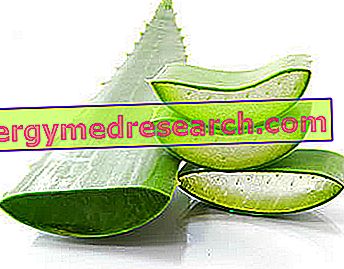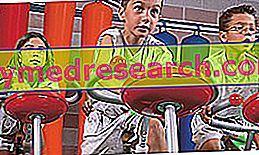Generality
Vitamins or "amines of life" are a heterogeneous set of organic substances (ESSENTIAL in small quantities) that do NOT supply energy and act with specific functions for:
- The development of the organism
- Proper BIOregulation of metabolic activities
- The constitution of enzymes and coenzymes.

The almost total lack of vitamins is called avitaminosis and the partial hypovitaminosis deficiency, but ATTENTION! The excess of vitamins can also determine hypervitaminosis, or a toxic state due to overdoses generally of a pharmacological nature.
Classification by solubility
Vitamins can be recognized by nomenclature or by a letter of the alphabet and are classified according to their chemical characteristics. The most common differentiation is that referred to water or fat solubility:
- Fat-soluble vitamins (soluble in fats): vitamin A (retinol and equivalents), vitamin D (calciferol and equivalents), vitamin E (tocopherols), vitamin K and "vitamin F" (essential fatty acids - AGE).
- Water- soluble vitamins ( water- soluble): C, B1, B2, B5, B6, PP, B12, Bc, H.
Water Soluble Vitamins
The water-soluble vitamins, as the term indicates, are soluble in water and, on balance, they are ALL molecules of group B together with vit. C:
- Vitamin C (antiscorbuto): L-ascorbic acid and dehydroascorbic acid are water-soluble in group C. They are found in fresh fruits and vegetables, such as oranges, lemons, grapefruit, kiwi, strawberries, melons, tomatoes and cabbage. Vitamin C is a powerful antioxidant and therefore also represents a good anti-tumor (especially as a preventive); keeps blood vessels intact and is a fundamental element for collagen synthesis; ascorbic acid regulates calcium metabolism (Ca), promotes intestinal absorption of iron (Fe) and determines the conversion of folic acid into folinic acid; it inhibits the synthesis of nitrosamines (carcinogenic compounds) in the digestive tract and is also protective against infectious diseases. Vitamin C is absorbed in the small intestine and deposited in the liver and adrenal glands; the deficiency generates: Scurvy and poor resistance to infections, while excess causes kidney stones (in subjects predisposed to calculi from oxalates, see article: diet and kidney stones), diarrhea and dyspepsia.
- Vitamin B1 (antiberiberica): it is a water-soluble vitamin better called thiamine or aneurine which is found mainly in whole grains (much less in refined ones), in wheat germ, in legumes, in liver, in molluscs and in mushrooms. It is a coenzyme of glucose metabolism, influences nerve impulse transmission and intervenes in the metabolism of ethyl alcohol. Vitamin B1 is absorbed in the intestine and deposited in the liver; the deficiency causes Beri-Beri, neurites and polyneurites while the pharmacological excess induces shock. They are anti-vitamins of B1: oxytiamine, juritiamine and thiaminase.
- Vitamin B2 (antidermatitica): it is a water-soluble vitamin also called riboflavin and in foods it is found: in the liver, in eggs, in milk, in fish, in whole grains and in mushrooms. Vitamin B2 is a constituent of the FAD and FMN coenzymes implicated in redox reactions but also participates in the maintenance of the mucosa. It is absorbed in the small intestine and stored in the liver; the deficiency manifests itself with lesions of the skin around the nose and the edges of the lips and with ocular sensitivity to light, while the excess (if existing) is not yet documented.
- Vitamin B3 or PP (antipellagrosa): nicotinic acid and nicotinamide are water-soluble vitamins of the PP group. Food sources are: liver, poultry, meat, tuna, legumes and milk (it also has a synthetic precursor, the essential amino acid tryptophan ). Intervenes in the metabolism of lipids, glucides and proteins, and participates in the formation of the NAD and NADP coenzymes. Vitamin PP is absorbed in the intestine and the deficiency determines Pellagra (photosensitive dermatitis, diarrhea and dementia) while excess causes headache, redness, itching, liver and intestine lesions, and allergies.
- Vitamin B5 (of growth): also called pantothenic acid, B5 is a water-soluble vitamin contained in the liver, meat, whole grains, eggs, vegetables and nuts. It is another coenzyme (CoA) important in the metabolism of lipids, glucides and proteins, as well as in the synthesis of cholesterol and steroid hormones. The vit. B5 is absorbed in the small intestine and, in the tissues, is in the form of CoA; the deficiency is unlikely due to its widespread use in foods, just as its symptoms and signs of excess are not known. The anti-vitamin of vit. B5 is an antimalarial drug.
- Vitamin B6 (antidermatitis): pyridoxine, pyridoxal and pyridoxamine are water-soluble vitamins of the B6 group. The major food sources are: whole grains, liver, spinach, peas and bananas; it is a constituent of coenzymes that participate in the metabolism of amino acids. It is absorbed in the small intestine and is deposited in the liver and brain; the deficiency, albeit rare, causes lesions of the skin, convulsions, vertigo and kidney stones, while excess (if possible) is not yet known.
- Vitamin B8 or vitamin H (antidermatitica): biotin and α-biotin are water-soluble H-group vitamins; it is contained in egg yolk, liver, kidney, green vegetables and meat but is also synthesized by intestinal bacterial flora. It is a coenzyme for the synthesis of fats, amino acids and carbohydrates; it is absorbed in the small intestine and the deficiency causes dermatitis, fatigue, depression, nausea, vomiting, loss of appetite and pain. The deficiency is not known. THERMOLABLE AND PHOTOSENSITIVE.
- Vitamin Bc or folic acid (antianemic): it is a water-soluble vitamin also called pteroyl-glutamic acid . It is contained in egg yolk, liver, kidneys, green vegetables, asparagus, wheat germ and legumes. Folic acid is a coenzyme that participates in the synthesis of nucleic acids, and in the reproduction of red and white blood cells. Bc is absorbed in the small intestine; its deficiency determines an anemic form called Megaloblastic, in addition to alterations of the mucous membranes, reddening of the tongue and diarrhea. There are no known symptoms of excess. The relative antivitaminici are the contraceptive and anticonvulsant drugs.
- Vitamin B12 or cobalamin (antianemic): there are different types of this water-soluble vitamin, all stored in the liver; it is found in active form exclusively in foods of animal origin: meat, eggs, fish, molluscs, liver, kidneys and milk. It is a coenzyme that has several functions: together with Bc it synthesizes nucleic acids, determines the replication of red blood cells and promotes the functioning of the nervous system; Vitamin B12 is absorbed in the intestine, even if only in a form linked to a mucoprotein secreted in the stomach, Castle's intrinsic factor . The deficiency causes an anemic form called pernicious anemia, in addition to nervous degeneration and digestive disorders; Vitamin B12 deficiency is frequent in vegetarians and especially in vegans, while the symptoms of excess are not known.
The water-soluble vitamins, except for the B2, B6 and partially for the B12, are ALL THERMOLABLE. Furthermore, C, B2, B6 and B8 have a good sensitivity to light while B1 has a negative effect on some preserving agents.
Reserve capacity of some water-soluble vitamins | ||
| RESERVE TIME | STORAGE OFFICES | |
| VITAMIN B1 | 4-10 days | muscle, liver, brain |
| VITAMIN B2 | 2-6 weeks | skeletal muscles, liver |
| VITAMIN B3 | 2-6 weeks | liver |
| VITAMIN B6 | 2-6 weeks | muscle, liver, brain |
| VITAMIN B9 (folic acid) | 3-4 months | liver |
| VITAMIN B12 | 3-5 years | liver |
| C VITAMIN | 2-6 weeks | brain, kidneys, adrenals, liver |



